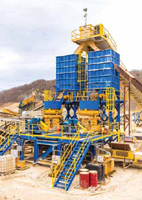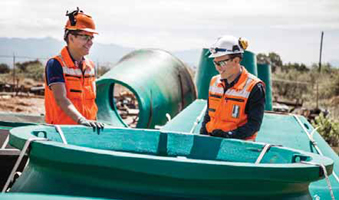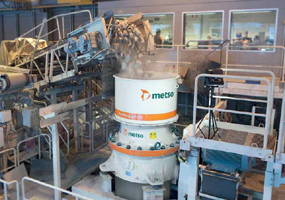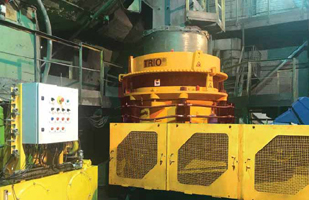
Cone crushing often provides the most economic and reliable method for secondary
crushing in mineral processing applications. (Photo: thyssenkrupp)
Perfecting the Performance of
Secondary Crushers
We ask eight industry experts how best to optimize the operation and throughput
of secondary crushing circuits
By Carly Leonida, European Editor

Cone crushing often provides the lowest operating cost and the most reliable method of production, although some operations with softer or less abrasive ores can use secondary sizers, horizontal shaft impactors, hammer mills, or other machines, each of which have varying benefits and drawbacks. Cone crushers are fed with prescreened material from the primary crusher (usually a jaw crusher or primary gyratory), and the secondary crusher should always, if possible, have a scalped feed. Ideally, the deck on the scalping screen should have a cut point equal to the closed side setting (CSS) of the crusher. The feed size to a secondary crusher is typically in the range of 50 mm to 250 mm (up to 300 mm). If the capacity is higher, the acceptable feed size gets larger. After crushing, the product is in the range of 0-60 mm (75 mm) diameter.
For mineral processing, secondary crushing can be used to prepare feed for downstream processes or to go directly to leaching. Downstream processes typically include tertiary crushing or primary grinding, with the tertiary crushers often being cone crushers or high-pressure grinding rolls (HPGRs), and the primary grinding mills being autogenous (AG) semiautogenous (SAG), or even rod or ball mills. In most applications, the secondary crusher has a primary target of maximizing the reduction ratio and reducing the top size and F80 for the downstream equipment. However, in some applications, the target can be also to avoid over-crushing in heap leaching applications, for example. In primary-secondary HPGR circuits, the secondary circuit can be closed with a screen to provide a consistent top size and gradation for optimizing HPGR performance. Closed circuited secondary crushing can also bring benefits if cones are used in tertiary crushing, too. However, the cost of the additional equipment is not always welcome.
Frank Drescher, head of the crushing technologies product line at thyssenkrupp Mining Technologies, explained: “A typical aim [for secondary crushing] in mining applications is to reach a grain size distribution with 100% of the material smaller than a defined maximum size. In some applications an additional requirement is to produce a minimum number of fines. A crusher is not able to directly produce a specific grain size, so the discharge always contains a wide range from fines up to a maximum size, plus oversize. The solution is a crushing circuit with an arrangement of a crusher, a subsequent screen and a conveyor to return the oversize to the crusher. “For example: If the following process requires 100% less than 80 mm without a high quantity of fines, the crusher can produce 90% less than 80 mm. After screening out the 0-80 mm fraction, the oversize that is more than 80 mm material is rejected to the crusher and crushed again. To crush the feed directly to 100% less than 80 mm would require a bigger machine, more energy and the amount of fines would significantly increase.”
Taking a Holistic View
on Optimization
The configuration of the secondary crushers
is usually specified at the project
phase based on a set of design criteria.
Tero Onnela, director for engineering
and RTD in the Crusher Wears business
line for Metso Outotec’s Consumables
business area, explained: “It’s common
that these conditions are not realized at
the start of plant operation, if ever. Since
the feed and ore properties will naturally
fl uctuate over time, it’s best to analyze
and optimize the crushing chamber designs,
operating setpoints, and equipment
configuration regularly as the feed
properties change over time.”

Drescher said: “On the one hand, you have to consider which machine represents a bottleneck and thus limits the fl ow of the production line. But it also makes sense to look at a line as a whole. If the entire crushing process is distributed over several machines arranged in sequence, then it’s possible to change the infl uence of individual crushers on the entire process by altering their settings. This then has an infl uence on the wear of the individual crushers and the particle size distribution in the final product.” For example, in a simple arrangement, if the primary crusher produces a high quantity of fines, then more material is screened out and less material is fed to the secondary crusher, thus reducing wear. Various factors can infl uence the process, for example, the feed material might change due to natural fl uctuations in crushability, hardness or moisture content. The product of individual crushing stages can also change due to wear of the crushing tools. In order to react to this, it’s important to regularly check the wear level of individual crushing stages as well as throughout the entire process.
Ekkhart Matthies, global applications director at Weir Minerals, said: “The most important thing to remember when assessing a crusher is — think about the bigger picture. No crusher works in a vacuum. Changes to one crusher often impact the equipment working alongside it and the stages that follow it.” While it’s important to routinely check on and evaluate critical pieces of machinery, refinements should be made with an application-wide view of the process or in partnership with application specialists. “Due to the arrival of Industrial Internet of Things (IIOT) and remote monitoring, it has never been easier to regularly check a crusher’s performance,” Matthies added. “Today, operators can monitor and analyze multiple pieces of equipment in real-time from the comfort of their desk.
This may tempt users to become focused on machine-by-machine improvements. However, emphasis should always be placed upon holistic, site-wide optimization. Our Synertrex IIOT platform offers users the ability to monitor the performance and health of Weir process equipment across their fl owsheet — providing valuable insight to inform their wider optimization initiatives.” Bill Malone, global product director for crushers at flSmidth, agreed: “It’s very important to monitor the settings and output from each crusher. And with modern control systems, this is possible. This ensures that a constant, or at least more normal product, is presented to the screens, which ensures stability in the system and therefore more consistent process results.
“Normally, the frequency of monitoring will depend on the wear characteristics of the material and how often corrections have to be made to compensate for this. So, for a high-wear material, possibly once or twice per shift and, for a lowwear material, perhaps once or twice per week. If you have modern control systems installed, they will take care of this function automatically.”
Anticipating the Need
for Change
When a complete circuit is running in a
consistent manner, varying output results
are the most obvious indicator for when
change is necessary. Secondary applications
are dependent on the primary
crusher to provide a targeted feed size, so
fl uctuations in the run-of-mine (ROM) ore
can contribute considerably.
Changes in gradation (i.e., feed getting
coarser or finer), hardness, moisture
or, if the work index increases or decreases, can trigger adjustments in screen panels
as well as potentially crusher mantles,
bowls and concaves to compensate.

“When downstream (tertiary) crushers are bottlenecking, it’s good to remember that it can be helped by secondary crusher performance,” Onnela said. “All crushing stages infl uence one another.” If circuit loads become too high, the process and settings should also be reviewed. “Changes to major operational figures such as tonnage, power usage and the life of wear parts are indications that there may have been a change to the crusher’s operating conditions,” Matthies said. “Monitoring a crusher’s tonnages is the quickest and most noticeable sign your crusher is not performing optimally. Is your crusher discharge in line with your expectations?
“By power usage we refer to how much electrical energy is being drawn from the motor, which is a subtler indication than tonnages. The motor’s amp reading can indicate if your crusher is suffering from lack of power, or if other factors are forcing your crusher to work harder to achieve its expected results.” Wear parts can also reveal a lot about a crusher’s condition. If wear patterns appear to have worn unusually or the life of the part has shortened, these suggest there are opportunities to alter the crusher’s settings and further improve its performance.
Focusing on Individual
Machines
To optimize the performance of individual
machines, the best course of action
is to maintain operation of the crusher
within three critical controlled variables:
volumetric capacity, power draw and
crushing force.
“Keeping the machine within these
parameters will lead to the most holistic
machine performance with regards to production
and reliability,” Steiner said.
One of the best places to start on the
optimization of individual machines is
with manipulated variables like the CSS
or speed. Sometimes controlled variables
such as power draw can be used to manipulate
crusher CSS and, lately online
product gradation analyzers have been
used to control crushers, aiming to stabilize
their performance. There are also additional
disturbance variables like crushing
chamber wear and feed size.

In specific cases, it’s also possible to change the crusher stroke by exchanging the eccentric throw arrangement. A basic prerequisite for an analysis is to know the particle size distribution and the mass fl ow rates of the crusher feed and discharge. By monitoring these parameters, the crushing process can be infl uenced by adjusting crushing gaps, speed, etc. “Timely replacement of crushing tools is also an important point to ensure the efficiency of the crushing process as it reduces downtime and assembly costs,” Richter said. “The shape of the crushing tools has an infl uence on the product, crushing forces, energy consumption and wear, as well as utilization rate and service life. They can therefore contribute significantly to the optimization of the crushing process.”
Wear Parts Play Key Role
Wear parts and crusher upgrades play
a highly critical role in crusher optimization,
and the materials used have the
potential to increase the service life and
thus the time during which a machine operates
optimally.
Steiner explained: “Optimization of
both crushing chamber profiles and wearpart
materials can have a tremendous impact
on machine performance, including
the throughput capacity, reduction ratio,
performance consistency and availability
by improving the liner life. Also, crusher
energy efficiency can be maximized by
designing an application-specific crushing
chamber. In some cases, reducing
energy requirements by tens of percent.”
Matthies agreed: “Wear parts are, in my opinion, one of the most important factors when optimizing a crusher. Using the correct liner configuration, operators can increase the tonnage and quality of end-product delivered by their equipment. Every feed curve has an optimum liner configuration. The design of a crusher’s wear liners hugely impacts the performance of the crusher and its uptime.”
Operators should also regularly check the crusher’s feed curve and the correlation between the motor power, chamber pressure and the tonnage. If the tonnage, motor power or crushing pressure is not what you would expect, there is room to optimize your crusher performance and the lifetime of its wear parts. High-quality wear parts not only help crushers perform, but they can also offer exceptional wear life, reducing downtime and contributing to an overall reduction in the site’s cost per ton.
The quality of wear part plays an integral role in optimization. However, wear part quality should not be confused with the percentage of manganese contained within the part. Manganese has been used in crushers for decades because of its work-hardening properties. As rocks meet the outer layer of the manganese particles, their exterior layer toughens. This results in a material that is harder to wear down during operation and can handle higher impact blows compared to other alloys.
“It’s a common misconception that more manganese increases the robustness of the wear part,” Matthies explained. “A manganese alloy will typically contain carbon, chrome and manganese elements. An increase in any of these ingredients will require adjustments to the wider recipe. Without considering the application and the wider formula, increases in manganese can result in weaker or less reliable parts. “Due to the importance of wear parts to the overall success of the project, I recommend that operators always source their parts from experienced suppliers and subject matter experts.”
Matthies said his team worked with an iron-ore mine in Russia supplying custom-engineered ESCO crusher liners, manufactured using premium alloys and an improved wear profile designed for that specific application. After the first set of ESCO liners were installed in the Trio TP600 crusher, the customer benefitted from four more days of wear life, a 16% increase in the bowl liner and a 20% increase in mantle utilization. Sven Hoerschkes, head of GPLM, construction and feeders at flSmidth, reported similar with his own customers: “In some cases, we’ve delivered 10% extra capacity and 30%-40% longer liner lifetimes by optimizing their profiles and the material composition,” he said. “It’s important to also check the screen performance too as this will affect the crusher significantly.”
Upgrades and, in extreme cases, machine replacements also provide the opportunity to reach new levels of safety, efficiency and performance. Steiner explained: “There are numerous cases across different crusher models where we have optimized equipment and/or provided upgrades to get the most out of the machine and in cases secondary crushers. From MP1000 to MP1250 upgrades that have seen a 25% increase in throughput, to upgrades of Symons crushers that can decrease downtime and increase availability by as much as 25%.”

From Machines to Circuits
Circuit optimization should start with
identifying the deficiencies and knowing
the goals surrounding throughput/
tonnage, material reduction, resource
consumption (energy, water, etc.), machine
reliability, machine availability
and total cost of ownership. Identifying
this gives information about where
adjustments need to be made and, on
what scale, from minor setting tweaks
to larger scale upgrades.
Drescher explained: “It’s necessary to
know and understand all the parameters
(feed material, feed granulation, product
granulation, mass fl ows), and the crushers
must be adjusted so that circuit loads
help improve the product and overall performance,
not reduce the output.
“For example, the primary crusher product size needs to be adjusted to the secondary crusher feed size or the AG/ SAG feed size, and also the secondary unit product size needs to be adjusted to the mill or HPGR feed size, which needs to be adjusted according to concentrator specifications. The same logic needs to be applied for throughput and feed rates. Inaccurate adjustments usually lead to overall reduced plant technoeconomic efficiency, especially if it’s an integrated plant.” This task should be performed at the early stages of a project because, once the steel or civil works are finished and equipment is installed, the available space sets up clear limitations for new or additional equipment installations. Arrangement changes can also carry extraordinary costs.
Circuit performance should be monitored throughout the life of the plant, and mines should conduct a full range of lab tests and run a complete plant simulation when looking to make significant changes. Every person interviewed for this article recommended engaging an expert at this stage. “I understand that some operations may have their own process engineers. However, I would always recommend that original equipment suppliers and associated process specialists are consulted when approaching any optimization project,” Matthies said. “It’s important that the team optimizing the process fully understands the ROM characteristics, the desired end-product and their infl uence on the machine’s settings and wider circuit.”
ROM characteristics provide operators with information on the product hardness, feed curve, abrasiveness — essentially predicting the fl ow sheet, equipment selection and possible equipment changes over time. Because of this, circuit optimization requires a macro viewpoint of all equipment and targets within a fl owsheet, along with a micro-view of crushers and other equipment on an individual basis. This can be hard for a mining company to achieve alone, and the utilization of experts at this stage can provide objective analysis and recommendations.
“When it comes to detailed specifics on the crushers themselves, the highest level of support comes from people who are knowledgeable in the design and operation of the equipment along with wider experiences,” Onnela said. “In our Chamber Optimization Program, Metso Outotec uses in-house developed simulation tools and laboratory equipment to study detailed parameters and understand the crushing circuit, and how changes also infl uence the other equipment.”
Crushing in the Digital Age
Improvements require measurements,
and the capability to detect improvement
potential from the measured data.
Applying the latest digital technologies
is adding an exciting new dimension to
bettering the performance and lifetime of
critical equipment such as crushers, and
the ability to process big data is enabling
valuable new performance and health-related
services.
Onnela explained: “Measuring inherent
variable crushing conditions
requires longer-term data to make
high-quality conclusions and profitable
decisions. In this work, digital technologies
are a key enabler.
“The ability to connect to crushers remotely allows access to huge amounts of accurate factual data. Supporting this, sensor development is also close to the level where we can talk about creating online digital twins of crushers, allowing scenario simulations and clear value-added action proposals based on data collected. “Sensor technology also diminishes the need for sampling data manually in conditions where people can face health and safety risks. Online sensing also gives a better overall view of the crusher performance condition compared to a sporadic sampling campaign.”
Digital technologies are essentially bridging the data gap between end-users and experts, allowing issues to be identified before they arise and preventative measures to be taken where necessary. With the rapid expansion of data collection and storage, many OEMs are now being asked to upgrade existing equipment so that performance data can be collected, quickly analyzed and reviewed regularly, leading to better performance and reliability. Having full equipment data insights is particularly important for the mining and aggregates industries given that equipment is typically dispersed over large areas. Being digitally connected enables operators and maintenance staff to monitor the performance and health of their equipment quickly from the safety of their office.
“With the array of sensors and optical devices now available, real-time monitoring and, more importantly, instantaneous reaction to the results obtained, allows us to operate the crusher under its most efficient conditions,” Malone concluded. “We also now have a better understanding of the predictability of component life, which allows us to proactively plan maintenance and changeout schedules and prevent major time loss due to failure. This all leads to a quicker and safer way to work with a lot less downtime.”